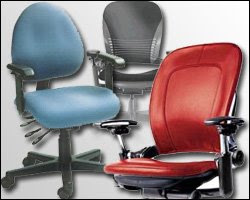 As an office worker who sit all days while working, an ergonomic chair is necessary to make one's workstation safer and healthier. Here's a good article about ergonomic chair. It discuss about why we need ergonomic chair, how to select an ergonomic chair, and the good features to look for when selecting an ergonomic chair.
As an office worker who sit all days while working, an ergonomic chair is necessary to make one's workstation safer and healthier. Here's a good article about ergonomic chair. It discuss about why we need ergonomic chair, how to select an ergonomic chair, and the good features to look for when selecting an ergonomic chair.What is an "ergonomic" chair?
Finding the right ergonomic chair is a common problem especially for people who want to purchase new equipment to make workstations safer and healthier places. There are many "ergonomic" chairs available but it can be a mistake to purchase one simply because it is labeled "ergonomic".
Ergonomic chairs are designed to suit a range of people; however, there is no guarantee that they will suit any one person in particular. For example, a chair could be too high and the arm rests too far apart for a short, slim person. In addition, chairs may not suit every task or arrangement at the workstation. A chair becomes ergonomic only when it specifically suits a worker's size (body dimensions), his or her particular workstation, and the tasks that must be performed there. It is possible to find the right chair although it is not always easy.
Why is finding the right chair so important?
Today, in industrialized countries, many people sit for most of the time that they are awake. They sit while having breakfast, while going to work in cars or buses, in school classrooms, in meetings, in offices, during dinner, and at home while watching television. Many people also sit at work operating machines which new technology has developed to replace manual work. Although sitting requires less physical effort than standing or walking it puts a lot of stress on lumbar area. Combined effects of a sedentary lifestyle and a job that requires sitting can lead to many health problems.
What do you need to know about selecting a good "ergonomic" chair?
The selection of a suitable chair is a critical step in preventing health problems in people who work in a sitting position. With the ergonomics approach, sitting is viewed as a specific, specialized activity which is influenced by the way that a sitting person interacts with the working environment.
Several basic concepts should be considered:
- One chair does not fit everyone. The users' body dimensions must be used when selecting a chair so that it does not strain one part of the body while fitting another.
- Collect data about the user's body height. The optimal seat height is about one quarter of the body height. This is only a rule of thumb since the torso-to-leg ratio can vary widely..
- No one chair is suitable for every activity. For example, dentists require a different chair than do industrial workers or computer operators
- Consider maintenance and repair costs. Check with the manufacturer for items to inspect for and how often inspection should be done.
What are the features of a "good" chair?
Some features are mandatory for a good chair regardless of how you intend to use it:
- Adjustability - Check to see that seat height is adjustable.
- Seat height range - Check whether the seat height can be adjusted to the height recommended for the worker(s) who will use it. Other chairs may have to be selected for very short or tall workers.
- Backrest - Check to see that the backrest is adjustable both vertically and in the frontward and backward direction.
- Seat depth - Select the seats that suit the tallest and the shortest users
- Stability - Check for the stability of the chair; a five-point base is recommended.
Other features to consider
- See if the selected chair has features that will help someone do their job better. Arm rests with adjustable heights are good for computer operators. Wider or narrower arm rests may also be required depending on the worker's dimensions and tasks they do.
- See if the selected chair has features that will make doing a job more difficult. An example may be that someone may be using a chair with casters or wheels when a stable and stationary work position would be better. If chairs with casters are needed, choose ones that match the type of flooring you have (carpeting or hard floors).
Who should pick out the chair?
Personal preference is essential to the process of selecting a chair.
- After some suitable chairs have been identified, allow the person who will use the chair most to try out the chair in a real work situation. It is especially useful to obtain several sample chairs for a trial comparison by those who will be using them.
- Make sure that the chair meets the needs of the workers and their jobs before any final selection is made.
Can a chair solve all of the ergonomic problems of working in a sitting position?
A well-designed chair allows the user to sit in a balanced position. Buying an ergonomic chair is a good beginning but it may not bring the benefits expected. The actual sitting position depends on an individual's personal habits; he or she has to learn and practice how to sit properly.
Also, remember that the chair is only one of the components to be considered in workstation design. All the elements such as the chair, footrest (if needed), work surface, document holders, task lighting and so on need to have flexibility and adjustability to be "designed in."
Source: ccohs.ca
More reading: osha.gov



No comments:
Post a Comment